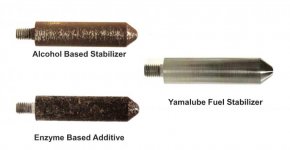Do none of you understand what sulfate salts do to the metals in a fuel system? When ethanol is added to fuel, there are sulfate salts in there as a residual, or contaminant, from the manufacturing of ethanol. You know, sulfuric acid? This stuff is VERY corrosive to metals like aluminum, steel, copper, yellow metals and silver solder. If you leave ethanol fuel in your tank all of the metal parts in the fuel system will CORRODE.
View attachment 77645
Here is a photo showing you what happens when you leave fuel in your machine that has been treated with three different types of stabilizer – alcohol based, enzyme based, and the new one I was telling you about from Yamaha. Actual test data, not some hyperbole or theory. Believe what you want, but you do not want to take your fuel system apart some day and find this in there. Ethanol fuels with this contaminant eat the guts out of your fuel system.
First, it's not research unless the report was published in a refereed journal. Please provide a URL to the "research" that was done. Unless you know what the metal alloy was, what solution the alloy was immersed in, for how long and at what temp, and what the concentration of H2SO4 or other corrosive was, that picture is meaningless. I must say, I'm quite leery of Yamaha Fuel Stabilizer and Conditioner Plus for two reasons: 1) I am unable to find an MSDS for it from either Yamaha's site or through a Google search. 2) Unlike Star Tron, Seafoam, Starbrite, Stabil, etc., Yamaha Fuel Stabilizer and Conditioner Plus is not registered with the EPA as a gasoline additive despite being required by Federal law to do so. (
http://www.epa.gov/otaq/fuels/registrationfuels/web-addt.htm#TOP) Since Yamaha is unwilling to provide an MSDS or to register their product with the EPA, I consider it to be even more snake oil than several other additives.
Second, how do sulfate salts get into the ethanol? How do yeast and a pure sugar + water substrate create sulfate salts that carry over into fractionally distilled EtOH? The two most common industrial techniques used to turn 190 proof ethanol into 200 proof dry ethanol use benzene or trichlorethylene to dry the ethanol. Neither of these compounds contain sulfur. (
http://journeytoforever.org/biofuel_library/ethanol_manual/manual12.html)
All gasoline contains sulfur. "Sulfur is a natural component in crude oil that ends up in gasoline and diesel unless removed." (
http://www.epa.gov/otaq/fuels/gasolinefuels/gasolinesulfur/index.htm) Since 2006, gasoline has had an 80 ppm limit for sulfur. (
http://www.gpo.gov/fdsys/pkg/FR-2000-02-10/pdf/00-19.pdf). That means every gallon of gasoline can contain up to .2 mg of sulfur, which can turn into sulfuric acid. While pure gas can absorb minute amounts of water, E10 gasoline can absorb greater amounts. This can be accentuated by using gasoline additives which contain alcohol or other water absorbing compounds. (
http://www.fuel-testers.com/is_gas_additive_safe_with_e10_list.html) So, for instance, Seafoam and Starbrite both contain alcohol and will only make the problem of sulfuric acid worse as will several marine fuel conditioners which also contain alcohol.
If you buy fresh E-10 gas and use it in a reasonable time period (3-4 weeks), there is no need for any additive. If you're going to store it for a longer period, use an additive which is known to be alcohol free, such as Stabil or Amsoil Gasoline Stabilizer. Because the Star*Tron MSDS does not fully account for all the compounds contained within it, there is always the possibility that up to 4.5% is alcohol. (
http://mystarbrite.com/startron/images/stories/msds/StarTron_MSDS_Gas_930XX.pdf)



